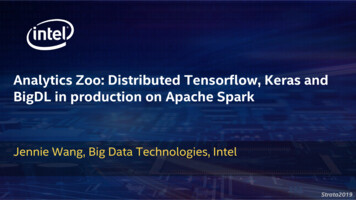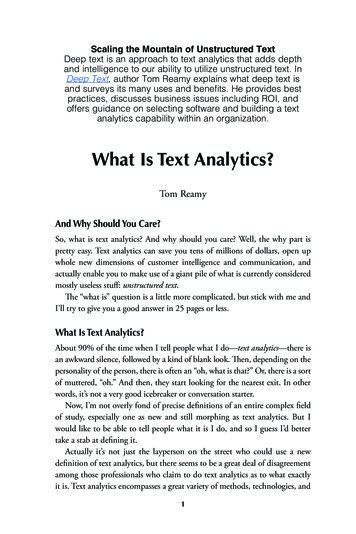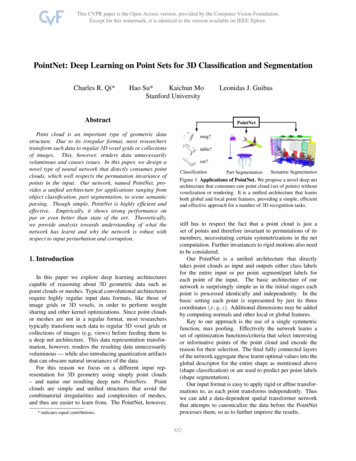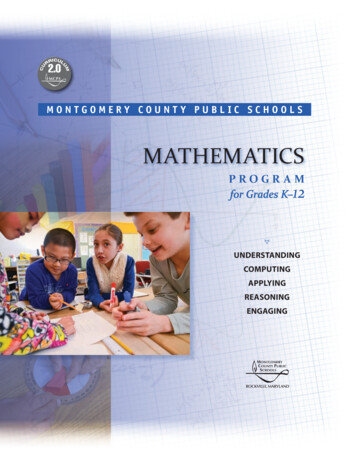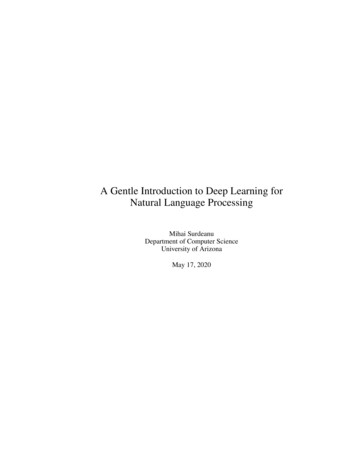
Transcription
A Gentle Introduction to Deep Learning forNatural Language ProcessingMihai SurdeanuDepartment of Computer ScienceUniversity of ArizonaMay 17, 2020
Contents123Preface . . . . . . . . . . . . . . . . . . . . . . . . . . . . . . . . . . . . . . . . .vIntroduction1.1 What this Book Covers . . . . .1.2 What this Book Does Not Cover1.3 Deep Learning Is Not Perfect . .1.4 Mathematical Notations . . . . .12456.77101017182022.23232527313333The Perceptron2.1 Machine Learning Is Easy . . .2.2 Use Case: Text Classification . .2.3 The Perceptron . . . . . . . . .2.4 Voting Perceptron . . . . . . . .2.5 Average Perceptron . . . . . . .2.6 Drawbacks of the Perceptron . .2.7 References and Further Readings.Logistic Regression3.1 The Logistic Regression Decision Function and Learning Algorithm3.2 The Logistic Regression Cost Function . . . . . . . . . . . . . . . .3.3 Gradient Descent . . . . . . . . . . . . . . . . . . . . . . . . . . .3.4 Deriving the Logistic Regression Update Rule . . . . . . . . . . . .3.5 Drawbacks of Logistic Regression . . . . . . . . . . . . . . . . . .3.6 References and Further Readings . . . . . . . . . . . . . . . . . . .4Implementing a Review Classifier Using Logistic Regression in DyNet355Feed Forward Neural Networks376Implementing the Review Classifier with Feed Forward Networks in DyNet397Distributional Similarity and Representation Learning418Implementing the Neural Review Classifier Using Word Embeddings43iii
ivCONTENTS9Best Practices in Deep Learning4510 Revisiting the Neural Review Classifier Implementation4711 Sequence Models4912 Implementing Sequence Models in DyNet5113 Sequence-to-sequence Methods5314 Transformer Networks5515 Domain Transfer5716 Semi-supervised Learning59
PrefaceAn obvious question that may pop up when seeing this material is: ”Why another deeplearning and natural language processing book?” Several excellent ones have been published,covering both theoretical and practical aspects of deep learning and its application to languageprocessing. However, from my experience teaching courses on natural language processing, Iargue that, despite their excellent quality, most of these books do not target their most likelyreaders. The intended reader of this book is one who is skilled in a domain other than machinelearning and natural language processing and whose work relies, at least partially, on theautomated analysis of large amounts of data, especially textual data. Such experts may includesocial scientists, political scientists, biomedical scientists, and even computer scientists andcomputational linguists with limited exposure to machine learning.Existing deep learning and natural language processing books generally fall into twocamps. The first camp focuses on the theoretical foundations of deep learning. This is certainlyuseful to the aforementioned readers, as one should understand the theoretical aspects of a toolbefore using it. However, these books tend to assume the typical background of a machinelearning researcher and, as a consequence, I have often seen students who do not have thisbackground rapidly get lost in such material. To mitigate this issue, the second type of bookthat exists today focuses on the machine learning practitioner; that is, on how to use deeplearning software, with minimal attention paid to the theoretical aspects. I argue that focusingon practical aspects is similarly necessary but not sufficient. Considering that deep learningframeworks and libraries have gotten fairly complex, the chance of misusing them due totheoretical misunderstandings is high. I have commonly seen this problem in my courses, too.This book, therefor, aims to bridge the theoretical and practical aspects of deep learningfor natural language processing. I cover the necessary theoretical background and assumeminimal machine learning background from the reader. My aim is that anyone who tooklinear algebra and calculus courses will be able to follow the theoretical material. To addresspractical aspects, this book includes pseudo code for the simpler algorithms discussed andactual Python code for the more complicated architectures. The code should be understandableby anyone who has taken a Python programming course. After reading this book, I expectthat the reader will have the necessary foundation to immediately begin building real-world,practical natural language processing systems, and to expand their knowledge by readingresearch publications on these topics.v
viCONTENTSAcknowledgmentsYour acknowledgments: TODO: Thank you!Mihai Surdeanu
1IntroductionMachine learning (ML) has become a pervasive part of our lives. For example, Pedro Domingos, a machine learning faculty member at University of Washington, discusses a typical dayin the life of a 21st century person, showing how she is accompanied by machine learningapplications throughout the day from early in the morning (e.g., waking up to music thatthe machine matched to her preferences) to late at night (e.g., taking a drug designed by abiomedical researcher with the help of a robot scientist) [Domingos 2015].Natural language processing (NLP) is an important subfield of ML. As an example ofits usefulness, consider that PubMed, a repository of biomedical publications built by theNational Institute of Health,1 has indexed more than one million research publications peryear since 2010 [Vardakas et al. 2015]. Clearly, no human reader (or team of readers) canprocess so much material. We need machines to help us manage this vast amount of knowledge. As one example out of many, an inter-disciplinary collaboration that included our research team showed that machine reading discovers an order of magnitude more proteinsignaling pathways2 in biomedical literature than exist today in humanly-curated knowledge bases [Valenzuela-Escárcega et al. 2018]. Only 60 to 80% of these automaticallydiscovered biomedical interactions are correct (a good motivation for not letting the machineswork alone!). But, without NLP, all of these would remain “undiscovered public knowledge” [Swanson 1986], limiting our ability to understand important diseases such as cancer.Other important and more common applications of NLP include web search, machine translation, and speech recognition, all of which have had a major impact in almost everyone’slife.Since approximately 2014, the “deep learning tsunami” has hit the field of NLP [Manning2015] to the point that, today, a majority of NLP publications use deep learning. For example,the percentage of deep learning publications at four top NLP conferences has increased fromunder 40% in 2012 to 70% in 2017 [Young et al. 2018]. There is good reason for thisdomination: deep learning systems are relatively easy to build (due to their modularity), andthey perform better than many other ML methods.3 For example, the site nlpprogress.com,which keeps track of state-of-the-art results in many NLP tasks, is dominated by results ofdeep learning approaches.1 https://www.ncbi.nlm.nih.gov/pubmed/2 Proteinsignaling pathways “govern basic activities of cells and coordinate multiple-cell actions”. Errors in thesepathways “may cause diseases such as cancer”. See: https://en.wikipedia.org/wiki/Cell signaling3 However, they are not perfect. See Section 1.3 for a discussion.1
2Chapter 1 IntroductionThis book explains deep learning methods for NLP, aiming to cover both theoretical aspects(e.g., how do neural networks learn?) and practical ones (e.g., how do I build one for languageapplications?).The goal of the book is to do this while assuming minimal technical background from thereader. The theoretical material in the book should be completely accessible to the reader whotook linear algebra, calculus, and introduction to probability theory courses, or who is willingto do some independent work to catch up. From linear algebra, the most complicated notionused is matrix multiplication. From calculus, we use differentiation and partial differentiation.From probability theory, we use conditional probabilities and independent events. The codeexamples should be understandable to the reader who took a Python programming course.Starting nearly from scratch aims to address the background of what we think will be thetypical reader of this book: an expert in a discipline other than ML and NLP, but who needsML and NLP for her job. There are many examples of such disciplines: the social scientistwho needs to mine social media data, the political scientist who needs to process transcripts ofpolitical discourse, the business analyst who has to parse company financial reports at scale,the biomedical researcher who needs to extract cell signaling mechanisms from publications,etc. Further, we hope this book will also be useful to computer scientists and computationallinguists who need to catch up with the deep learning wave. In general, this book aims tomitigate the impostor syndrome [Dickerson 2019] that affects many of us in this era of rapidchange in the field of machine learning and artificial intelligence (this author certainly hassuffered and still suffers from it!4 ).1.1What this Book CoversThis book interleaves chapters that discuss the theoretical aspects of deep learning for NLPwith chapters that focus on implementing the previously discussed theory. For the implementation chapters we will use DyNet, a deep learning library that is well suited for NLPapplications.5Chapter 2 begins the theory thread of the book by attempting to convince the readerthat machine learning is easy. We will use a children’s book to introduce key ML concepts,including our first learning algorithm. From this example, we will start building several basicneural networks. In the same chapter, we will formalize the Perceptron algorithm, the simplestneural network. In Chapter 3, we will transform the Perceptron into a logistic regressionnetwork, another simple neural network that is surprisingly effective for NLP. In Chapter 5,we will generalize these algorithms to derive feed forward neural networks, which operateover arbitrary combinations of artificial neurons.4 Eventhe best of us suffer from it. Please see Kevin Knight’s description of his personal experience involving tears(not of joy) in the introduction of this tutorial [Knight 2009].5 http://dynet.io
1.1 What this Book Covers 3The astute historian of deep learning will have observed that deep learning had an impact earlier on image processing than on NLP. For example, in 2012, researchers at University of Toronto reported a massive improvement in image classification when using deeplearning [Krizhevsky et al. 2012]. However, it took more than two years to observe similarperformance improvements in NLP. One explanation for this delay is that image processingstarts from very low-level units of information (i.e., the pixels in the image), which are thenhierarchically assembled into blocks that are more and more semantically meaningful (e.g.,lines and circles, then eyes and ears, in the case of facial recognition). In contrast, NLP startsfrom words, which are packed with a lot more semantic information than pixels and, becauseof that, are harder to learn from. For example, the word house packs a lot of commonsenseknowledge (e.g., houses generally have windows and doors and they provide shelter). Although this information is shared with other words (e.g., building), a learning algorithm thathas seen house in its training data will not know how to handle the word building in a newtext to which it is exposed after training.Chapter 7 addresses this limitation. In it, we discuss methods to transform words into anumerical representation that captures (some) semantic knowledge. This technique is basedon an observation that “you shall know a word by the company it keeps” [Firth 1957]; thatis, it learns from the context in which words appear in large collections of texts. Under thisrepresentation, similar words such as house and building will have similar representations,which will improve the learning capability of our neural networks.Chapter 9 discuss best practices when training neural networks, such as how to train neuralnetworks for multi-class classification (i.e., for tasks that need to predict more than two labels),and how to make the training process more robust.Chapter 11 introduces sequence models for processing text. For example, while the wordbook is syntactically ambiguous (i.e., it can be either a noun or a verb), knowing that it ispreceded by the determiner the in a text gives strong hints that this instance of it is a noun.In this chapter, we will cover neural network architectures designed to model such sequences,including recurrent neural networks, convolutional neural networks, long short-term memorynetworks, and long short-term memory networks combined with conditional random fields.Chapter 13 discusses sequence-to-sequence methods (i.e., methods tailored for NLP taskswhere the input is a sequence and the output is another sequence). The most common exampleof such a task is machine translation; where the input is a sequence of words in one language,and the output is a sequence that captures the translation of the original text in a new language.Chapter 14 introduces transformer networks, a more recent take on sequence-to-sequencemethods which replaces the sequence modeling (traditionally used in these approaches) with“attention”. Attention is a mechanism that computes the representation of a word using aweighted average of the representations of the words in its context. These weights are learnedand indicate how much ”attention” each word should put on each of its neighbors (hence thename).
4Chapter 1 IntroductionChapter 15 discusses methods that begin to address the “brittleness” of deep learning whentransferring a model from one domain to another. For example, the performance of a part-ofspeech tagging system (i.e., identifying which words are nouns, verbs, etc.) that is trained onwell-formed texts, such as newspaper articles, drops precipitously when used on social mediatexts (see Section 1.3 for a longer discussion).Lastly, Chapter 16 discusses approaches for training neural networks with minimal supervision. For example, training a neural network to detect spam emails normally requires manyexamples of emails that are/are not spam. In this chapter, we introduce a few recent directionsin deep learning that allow the training of a network from a few examples that are annotatedwith the desired outcome (e.g., spam or not spam) and with many others that are not.As previously mentioned, the theoretical discussion in these chapters is interleaved withchapters that discuss how to implement these notions in DyNet. Chapter 4 shows an implementation of the logistic regression algorithm introduced in Chapter 3. Chapter 6 introducesan implementation of the basic feed forward neural network introduced in Chapter 5. Chapter 8 enhances the previous implementation of a neural network with the continuous wordrepresentations introduced in Chapter 7. Chapter 10 further refines this implementation withthe concepts introduced in Chapter 9. Lastly, Chapter 12 implements the sequence modelsintroduced in Chapter 11.1.2What this Book Does Not CoverIt is important to note that deep learning is only one of the many subfields of machinelearning. In his book, Domingos provides an intuitive organization of these subfields intofive “tribes” [Domingos 2015]:Connectionists This tribe focuses on machine learning methods that (shallowly) mimic thestructure of the brain. The methods described in this book fall into this tribe.Evolutionaries The learning algorithms adopted by this group of approaches, also knownas genetic algorithms, focus on the “survival of the fittest”. That is, these algorithms“mutate” the “DNA“ (or parameters) of the models to be learned, and preserve thegenerations that perform the best.Symbolists The symbolists rely on inducing logic rules that explain the data in the task athand. For example, a part-of-speech tagging system in this camp may learn a rule suchas if previous word is the, then the part of the speech of the next word is noun.Bayesians The Bayesians use probabilistic models such as Bayesian networks. All thesemethods are driven by Bayes’ rule, which describes the probability of an event.Analogizers The analogizers’ methods are motivated by the observation that “you are whatyou resemble”. For example, a new email is classified as spam because it uses contentsimilar to other emails previously classified as such.
1.3 Deep Learning Is Not Perfect 5It is beyond the goal of this book to explain these other tribes in detail. Even from the connectionist tribe, we will focus mainly on methods that are relevant for language processing.6For a more general description of machine learning, the interested reader should look to othersources such as Domingos’ book, or Hal Daumé III’s excellent Course in Machine Learning.71.3Deep Learning Is Not PerfectWhile deep learning has pushed the performance of many machine learning applicationsbeyond what we thought possible just ten years ago, it is certainly not perfect. Gary Marcusand Ernest Davis provide a thoughtful criticism of deep learning in their book, RebootingAI [Marcus and Davis 2019]. Their key arguments are:Deep learning is opaque While deep learning methods often learn well, it is unclear whatis learned, i.e., what the connections between the network neurons encode. This isdangerous, as biases and bugs may exist in the models learned, and they may bediscovered only too late, when these systems are deployed in important real-worldapplications such as diagnosing medical patients, or self-driving cars.Deep learning is brittle It has been repeatedly shown both in the machine learning literatureand in actual applications that deep learning systems (and for that matter most othermachine learning approaches) have difficulty adapting to new scenarios they have notseen during training. For example, self-driving cars that were trained in regular traffic onUS highways or large streets do not know how to react to unexpected scenarios such asa firetruck stopped on a highway.8Deep learning has no commonsense An illustrative example for this limitation is that objectrecognition classifiers based on deep learning tend to confuse objects when they are rotated in three dimensional space, e.g., an overturned bus in the snow is confused with asnow plow. This happens because deep learning systems lack the commonsense knowledge that some object features are inherent properties of the category itself regardless ofthe object position, e.g., a school bus in the US usually has a yellow roof, while some features are just contingent associations, e.g., snow tends to be present around snow plows.(Most) humans naturally use commonsense, which means that we do generalize better tonovel instances, especially when they are outliers.All the issues raised by Marcus and Davis are unsolved today. However, we will discuss somedirections that begin to address them in this book. For example, in Chapter 13 we will discussalgorithms that (shallowly) learn commonsense knowledge from large collections of texts.6 Mostof methods discussed in this book are certainly useful and commonly used outside of NLP as well.7 http://ciml.info8 crash-details/
6Chapter 1 IntroductionIn Chapter 15 we will introduce strategies to mitigate the pain in transferring deep learningmodels from one domain to another.1.4Mathematical NotationsWhile we try to rely on plain language as much as possible in this book, mathematicalformalisms cannot (and should not) be avoided. Where mathematical notations are necessary,we rely on the following conventions: We use lower case characters such as x to represent scalar values, which will generallyhave integer or real values. We use bold lower case characters such x to represent arrays (or vectors) of scalarvalues, and xi to indicate the scalar element at position i in this vector. Unless specifiedotherwise, we consider all vectors to be column vectors during operations such asmultiplication, even though we show them in text as horizontal. We use [x; y] to indicatevector concatenation. For example, if x (1, 2) and y (3, 4), then [x; y] (1, 2, 3, 4). We use bold upper case characters such as X to indicate matrices of scalar values.Similarly, xi j points to the scalar element in the matrix at row i and column j. xi indicatesthe vector corresponding to the entire row i in matrix X.
2The PerceptronThis chapter covers the Perceptron, the simplest neural network architecture, which willform the building block for the more complicated architectures discussed later in the book.However, rather than starting directly with the discussion of this algorithm, we will startwith something simpler: a children’s book and some fundamental observations about machinelearning. From these, we will formalize our first machine learning algorithm, the Perceptron.In the following chapters, we will improve upon the Perceptron with logistic regression(Chapter 3), and deeper feed forward neural networks (Chapter 5).2.1Machine Learning Is EasyMachine learning is easy. To convince you of this, let us read a children’s story [Donaldsonand Scheffler 2008]. The story starts with a little monkey that lost her mom in the jungle(Figure 2.1). Luckily, the butterfly offers to help, and collects some information about themother from the little monkey (Figure 2.2). As a result, the butterfly leads the monkey to anelephant. The monkey explains that her mom is neither gray nor big, and does not have atrunk. Instead, her mom has a “tail that coils around trees”. Their journey through the junglecontinues until, after many mistakes (e.g., snake, spider), the pair end up eventually findingthe monkey’s mom, and the family is happily reunited.In addition of the exciting story that kept at least a toddler and this parent glued to its pages,this book introduces several fundamental observations about (machine) learning.First, objects are described by their properties, also known in machine learning terminology as features. For example, we know that several features apply to the monkey mom:isBig, hasTail, hasColor, numberOfLimbs, etc. These features have values, whichmay be Boolean (true or false), a discrete value from a fixed set, or a number. For example,the values for the above features are: false, true, brown (out of multiple possible colors), and 4. As we will see soon, it is preferable to convert these values into numbers. Forthis reason, Boolean features are converted to 0 for false, and 1 for true. Features that takediscrete values are converted to Boolean features by enumerating over the possible valuesin the set. For example, the color feature is converted into a set of Boolean features such ashasColorBrown with the value true (or 1), hasColorRed with the value false (or0), etc.Second, objects are assigned a discrete label, which the learning algorithm or classifier(the butterfly has this role in our story) will learn how to assign to new objects. For example,in our story we have two labels: isMyMom and isNotMyMom. When there are two labels to7
8Figure 2.1Chapter 2 The PerceptronAn exciting children’s book that introduces the fundamentals of machine learning: Where’sMy Mom, by Julia Donaldson and Axel Scheffler [Donaldson and Scheffler 2008].be assigned such as in our story, we call the problem at hand a binary classification problem.When there are more than two labels, the problem becomes a multiclass classification task.Sometimes, the labels are continuous numeric values, in which case we have a regressionproblem. An example of such a regression problem would be learning to forecast the price ofa house on the real estate market from its properties, e.g., number of bedrooms, and year itwas built. However, in NLP most tasks are classification problems (we will see some simpleones in this chapter, and more complex ones starting with Chapter 11).To formalize what we know so far, we can organize the examples the classifier has seen(also called a training dataset) into a matrix of features X and a vector of labels y. Eachexample seen by the classifier takes a row in X, with each of the features occupying a differentcolumn. Table 2.1 shows an example of a possible matrix X and label vector y for threeanimals in our story.The third observation is that a good learning algorithm aggregates its decisions overmultiple examples with different features. In our story the butterfly learns that some featuresare positively associated with the mom (i.e., she is likely to have them), while some arenegatively associated with her. For example, from the animals the butterfly sees in the story,
2.1 Machine Learning Is Easy 9Little monkey: “I’ve lost my mom!”“Hush, little monkey, don’t you cry. I’ll help you find her,” said butterfly. “Let’s havea think, How big is she?”“She’s big!” said the monkey. “Bigger than me.””Bigger than you? Then I’ve seen your mom. Come, little monkey, come, come,come.”“No, no, no! That’s an elephant.”Figure 2.2The butterfly tries to help the little monkey find her mom, but fails initially [Donaldson andScheffler 2008]. TODO: check fair use!Table 2.1An example of a possible feature matrix X (left table) and a label vector y (right table) forthree animals in our story: elephant, snake, and it learns that the mom is likely to have a tail, fur, and four limbs, and she is not big, doesnot have a trunk, and her color is not gray. We will see soon that this is exactly the intuitionbehind the simplest neural network, the Perceptron.Lastly, learning algorithms produce incorrect classifications when not exposed to sufficientdata. This situation is called overfitting, and it is more formally defined as the situation whenan algorithm performs well in training (e.g., once the butterfly sees the snake, it will reliablyclassify it as not the mom when it sees in the future), but poorly on unseen data (e.g., knowingthat the elephant is not the mom did not help much with the classification of the snake).To detect overfitting early, machine learning problems typically divide their data into threepartitions: (a) a training partition from which the classifier learns; (b) a development partitionthat is used for the internal validation of the trained classifier, i.e., if it performs poorly on thisdataset, the classifier has likely overfit; and (c) a testing partition that is used only for the final,formal evaluation. Machine learning developers typically alternate between training (on thetraining partition) and validating what is being learned (on the development partition) untilacceptable performance is observed. Once this is reached, the resulting classifier is evaluated(ideally once) on the testing partition.
102.2Chapter 2 The PerceptronUse Case: Text ClassificationIn the remaining of this chapter, we will begin to leave the story of the little monkey behindus, and change to a related NLP problem, text classification, in which a classifier is trained toassign a label to a text. This is an important and common NLP task. For example, emailproviders use binary text classification to classify emails into spam or not. Data miningcompanies use multiclass classification to detect how customers feel about a product, e.g.,like, dislike, or neutral. Search engines use multiclass classification to detect the language adocument is written in before processing it.Throughout this chapter, we will focus on binary text classification for simplicity. We willgeneralize the algorithms discussed to multiclass classification in Chapter 9. We will introducemore complex NLP tasks starting with Chapter 11.For now, we will extract simple features from the texts to be classified. That is, we willsimply use the frequencies of words in a text as its features. More formally, the matrix X willhave as many columns as words in the vocabulary. Each cell xi j corresponds to the number oftimes the word at column j occurs in the text stored at row i. For example, the text This is agreat great buy will produce a feature corresponding to the word buy with value 1, one for theword great with value 2, etc., while the features corresponding to all the other words in thevocabulary that do not occur in this document receive a value of 0.2.3The PerceptronThe Perceptron algorithm was invented by Frank Rosenblatt in 1958. Its aim is to mimic thebehavior of a single neuron [Rosenblatt 1958]. Figure 2.3 shows a depiction of a biologicalneuron,1 and Rosenblatt’s computational simplification, the Perceptron. As the figure shows,the Perceptron is the simplest possible artificial neural network. We will generalize from thissingle-neuron architecture to networks with an arbitrary number of neurons in Chapter 5.The Perceptron has one input for each feature of an example x, and produces an outputthat corresponds to the label predicted for x. Importantly, the Perceptron has a weight vectorw, with one weight wi for each input connection i. Thus, the size of w is equal to the numberof features, or the number of columns in X. Further, the Perceptron also has a bias term, b,that is scalar (we will explain why this is needed later in this section). The Perceptron outputsa binary decision, let us say Yes or No (e.g., Yes, the text encoded in x contains a positivereview for a product, or No, the review is negative), based on the decision function describedin Algorithm 1. The w · x component of the decision functi
Since approximately 2014, the “deep learning tsunami” has hit the field of NLP [Manning 2015] to the point that, today, a majority of NLP publications use deep learning. For example, the percentage of deep learning publications at four top NLP conferences has increased f


